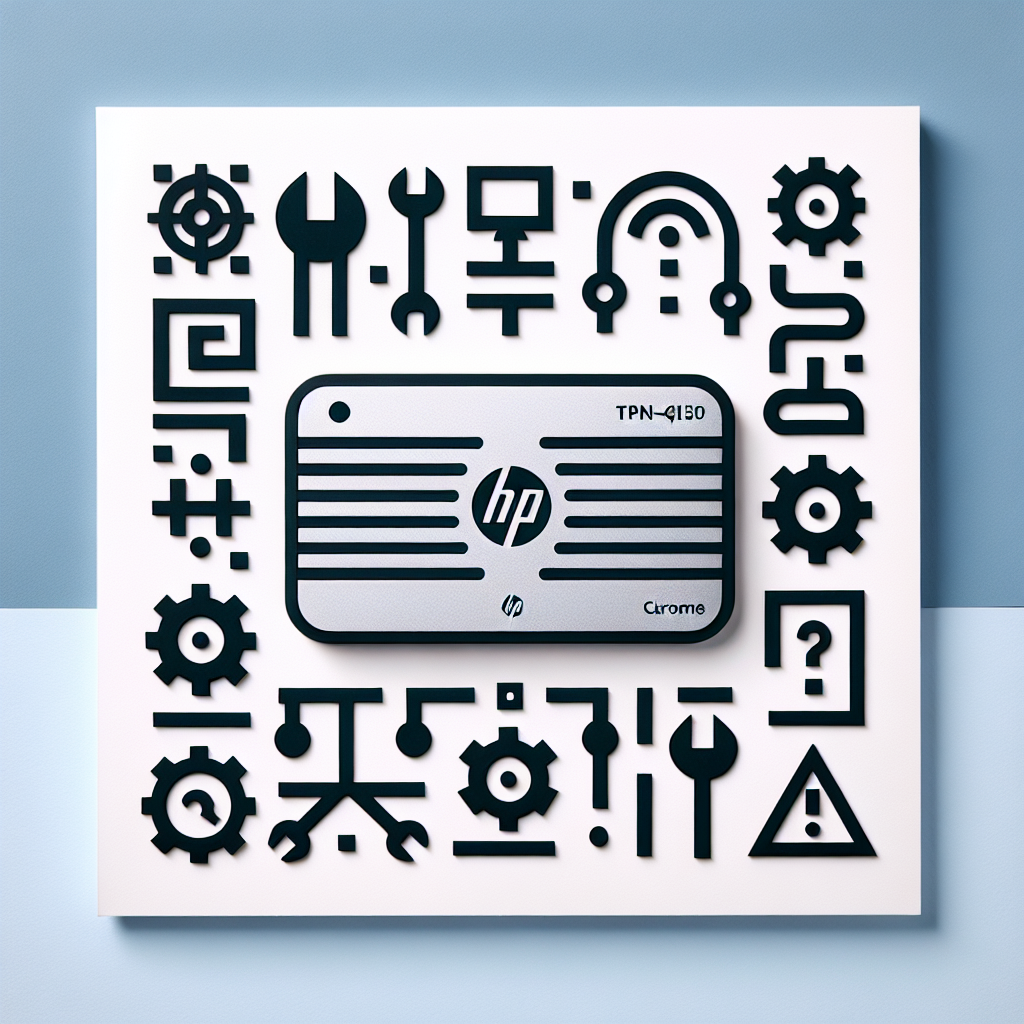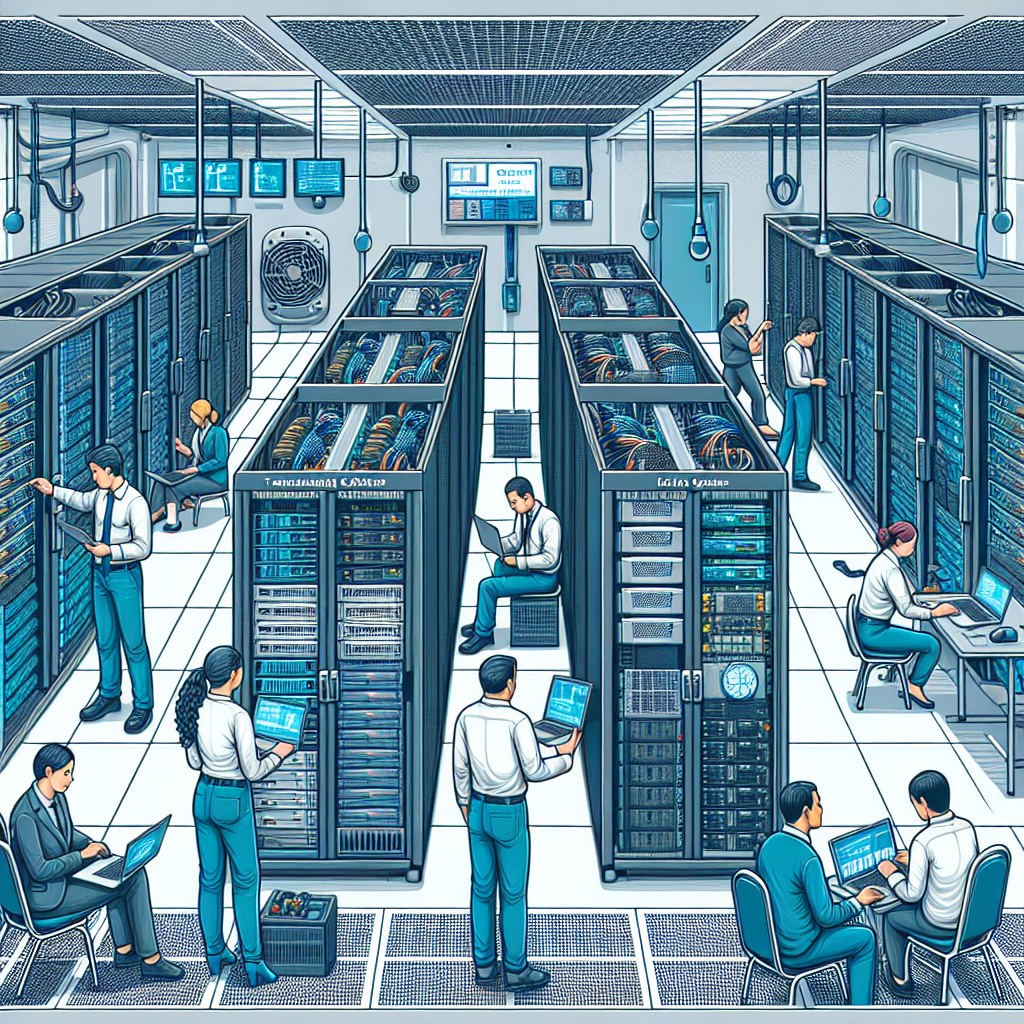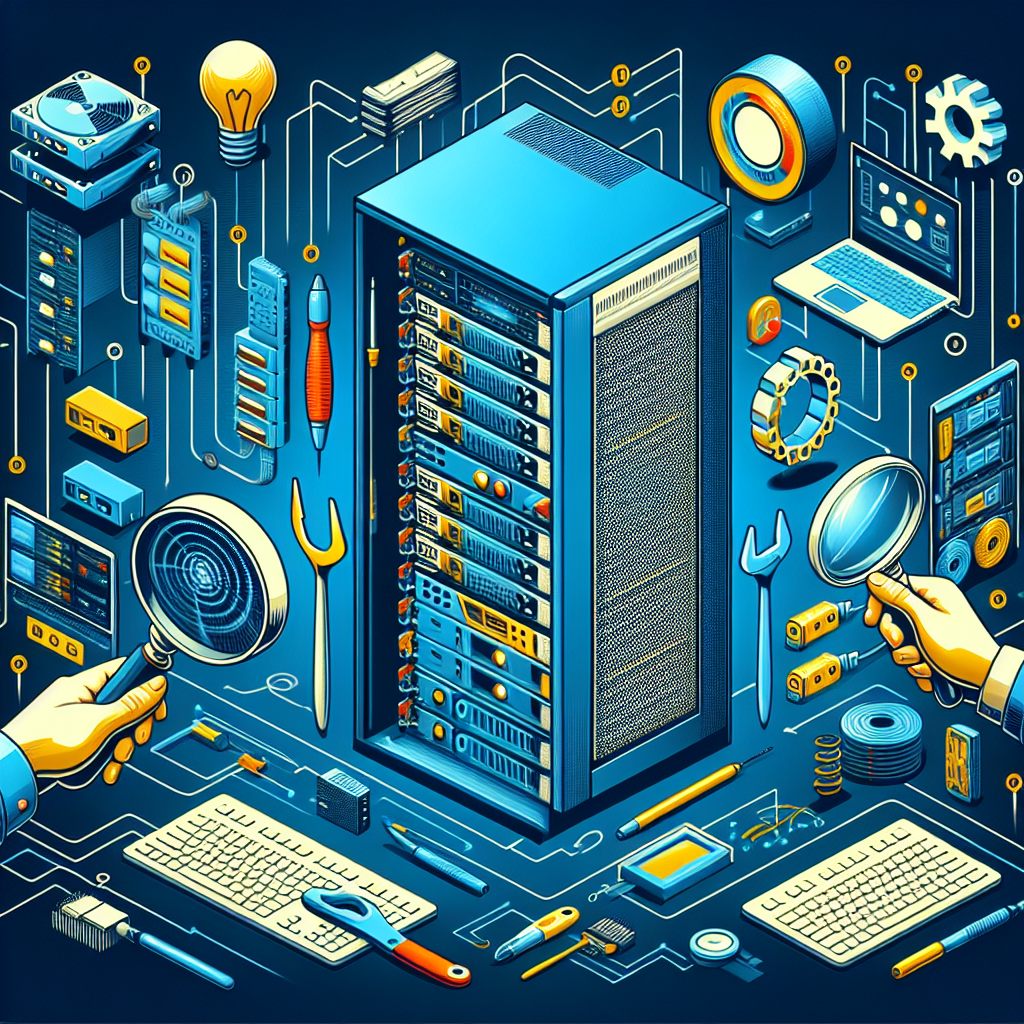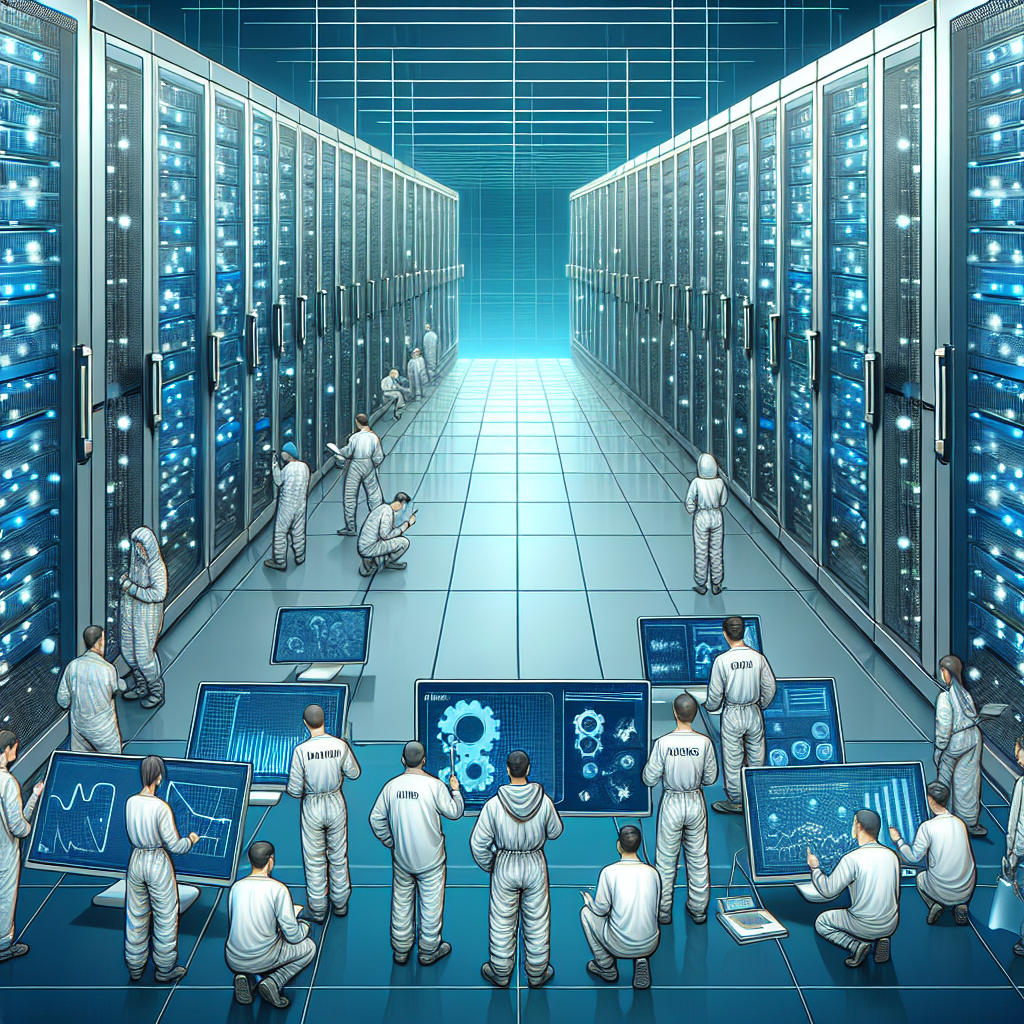Your cart is currently empty!
Tag: Troubleshooting

The Ultimate Guide to Data Center Troubleshooting: Best Practices and Strategies
Data centers are the backbone of modern businesses, housing the critical infrastructure that supports operations and data storage. When issues arise in a data center, downtime can be costly and detrimental to the overall functioning of an organization. That’s why having a solid troubleshooting plan in place is essential for maintaining the health and efficiency of a data center.In this article, we will discuss some best practices and strategies for troubleshooting data center issues. By following these guidelines, IT professionals can effectively identify and resolve problems quickly, minimizing downtime and ensuring optimal performance.
1. Establish a comprehensive monitoring system: The first step in effective data center troubleshooting is having a robust monitoring system in place. This system should track key performance metrics, such as temperature, power usage, and network traffic, in real-time. By monitoring these metrics, IT professionals can quickly identify any anomalies or issues that may arise.
2. Create a troubleshooting playbook: A troubleshooting playbook is a comprehensive document that outlines common data center issues and their corresponding solutions. This playbook should include step-by-step instructions for diagnosing and resolving common problems, as well as contact information for key stakeholders and vendors. By having a playbook on hand, IT professionals can quickly reference the appropriate steps to take when troubleshooting an issue.
3. Conduct regular maintenance and updates: Regular maintenance and updates are essential for preventing issues from arising in the first place. IT professionals should regularly inspect and maintain data center equipment, such as servers, switches, and cooling systems, to ensure they are functioning properly. Additionally, staying up-to-date on software updates and security patches can help prevent potential vulnerabilities that could lead to downtime.
4. Use remote monitoring and management tools: Remote monitoring and management tools allow IT professionals to monitor and manage data center equipment from anywhere, providing real-time visibility into the health and performance of the data center. These tools can help identify issues before they escalate, allowing for quick resolution and minimizing downtime.
5. Implement a comprehensive disaster recovery plan: Despite best efforts to prevent issues, data center downtime can still occur. Having a comprehensive disaster recovery plan in place is essential for minimizing the impact of downtime on business operations. This plan should include procedures for data backup and recovery, as well as alternative communication and power sources in the event of a disaster.
In conclusion, data center troubleshooting is a critical aspect of maintaining the health and efficiency of a data center. By following best practices and implementing effective strategies, IT professionals can quickly identify and resolve issues, minimizing downtime and ensuring optimal performance. Establishing a comprehensive monitoring system, creating a troubleshooting playbook, conducting regular maintenance and updates, using remote monitoring and management tools, and implementing a disaster recovery plan are key steps in effective data center troubleshooting. By following these guidelines, organizations can ensure their data center operations run smoothly and efficiently.

Troubleshooting Common Issues with the HP Chromebox G1 TPN-Q150
The HP Chromebox G1 TPN-Q150 is a compact and versatile computer that is perfect for both personal and professional use. However, like any electronic device, it can sometimes encounter issues that may disrupt your workflow. Here are some common problems with the HP Chromebox G1 TPN-Q150 and how to troubleshoot them.1. Slow performance:
If you notice that your HP Chromebox G1 TPN-Q150 is running slower than usual, there are a few steps you can take to improve its performance. First, make sure that your device is up to date with the latest software updates. You can do this by going to the settings menu and checking for updates. Additionally, try clearing out any unnecessary files or programs that may be taking up space on your device. You can also try restarting your Chromebox to see if that helps speed up its performance.
2. Connectivity issues:
If you are having trouble connecting to the internet or other devices, there are a few things you can try to troubleshoot the issue. First, check to make sure that your Wi-Fi network is working properly and that you are within range of the router. If you are still having trouble connecting, try restarting your Chromebox and your router to see if that resolves the issue. You can also try connecting to a different network to see if the problem is with your current connection.
3. Screen flickering or freezing:
If you are experiencing screen flickering or freezing on your HP Chromebox G1 TPN-Q150, there are a few possible causes. First, try adjusting the display settings on your device to see if that resolves the issue. You can also try restarting your Chromebox to see if that helps. If the problem persists, it may be a hardware issue, and you may need to contact HP customer support for further assistance.
4. Audio issues:
If you are having trouble with the audio on your HP Chromebox G1 TPN-Q150, there are a few things you can try to troubleshoot the problem. First, make sure that the volume on your device is turned up and that the audio settings are configured correctly. You can also try connecting external speakers or headphones to see if the issue is with the internal speakers. If the problem persists, you may need to update the audio drivers on your Chromebox or contact HP customer support for further assistance.
Overall, the HP Chromebox G1 TPN-Q150 is a reliable and efficient device, but like any electronic device, it can encounter issues from time to time. By following these troubleshooting tips, you can quickly identify and resolve common problems with your Chromebox and get back to using it with ease.

Understanding the Power of a WoWPC Recovery USB Drive for PC Troubleshooting
In today’s digital age, it’s not uncommon for our computers to experience technical issues or malfunctions. Whether it’s a software glitch, a virus attack, or a hardware failure, these problems can be frustrating and disruptive to our daily routines. Fortunately, there are tools available that can help us troubleshoot and resolve these issues quickly and efficiently.One such tool is a WoWPC recovery USB drive. This powerful tool is designed to help users troubleshoot and repair their computers when they encounter problems. With a WoWPC recovery USB drive, users can easily boot their computers from the USB drive and access a range of troubleshooting and repair tools that can help them diagnose and fix the issue at hand.
One of the key benefits of using a WoWPC recovery USB drive is its convenience and portability. Unlike traditional recovery CDs or DVDs, a USB drive is small and lightweight, making it easy to carry around and use on the go. This means that users can quickly access their troubleshooting tools and repair their computers wherever they are, whether at home, in the office, or on the go.
Another benefit of using a WoWPC recovery USB drive is its versatility. These drives typically come pre-loaded with a range of diagnostic and repair tools, including antivirus programs, disk repair utilities, and system restore options. This means that users have all the tools they need to troubleshoot and fix a wide range of computer issues, from software glitches to hardware failures.
In addition, using a WoWPC recovery USB drive can help users save time and money. Instead of having to take their computer to a repair shop or wait for a technician to come to their home, users can quickly and easily troubleshoot and repair their computers themselves, saving both time and money in the process.
Overall, a WoWPC recovery USB drive is a powerful tool that can help users troubleshoot and repair their computers quickly and efficiently. With its convenience, versatility, and cost-saving benefits, it’s a must-have tool for anyone who wants to keep their computer running smoothly and efficiently.

10 Common Data Center Troubleshooting Tips Every IT Professional Should Know
Data centers are the backbone of any organization’s IT infrastructure, providing the necessary storage, processing power, and networking capabilities to keep operations running smoothly. However, even the most well-maintained data centers can encounter issues that require troubleshooting to resolve. As an IT professional responsible for maintaining a data center, it is crucial to be equipped with the knowledge and skills to effectively troubleshoot common problems that may arise. Here are 10 common data center troubleshooting tips every IT professional should know.1. Monitor performance metrics: Regularly monitoring performance metrics such as CPU usage, memory utilization, network traffic, and storage capacity can help identify potential issues before they escalate into major problems.
2. Check for hardware failures: Hardware failures are a common cause of data center downtime. Regularly check hardware components such as servers, storage devices, and networking equipment for signs of failure, such as overheating, unusual noises, or error messages.
3. Verify power and cooling systems: Data centers rely on power and cooling systems to maintain optimal operating conditions. Ensure that power sources are stable, backup generators are functioning properly, and cooling systems are effectively managing temperature levels.
4. Review network configurations: Incorrect network configurations can lead to connectivity issues and performance degradation. Review network settings, VLAN configurations, and firewall rules to ensure they are properly configured.
5. Update software and firmware: Outdated software and firmware can leave data center systems vulnerable to security threats and performance issues. Regularly update operating systems, applications, and firmware to ensure they are running the latest versions.
6. Monitor environmental conditions: Data centers are sensitive to environmental conditions such as temperature, humidity, and airflow. Monitor these conditions regularly and make adjustments as needed to maintain optimal operating conditions.
7. Investigate network connectivity issues: Network connectivity issues can disrupt data center operations and impact user experience. Use network monitoring tools to identify the root cause of connectivity issues and troubleshoot accordingly.
8. Check for storage capacity issues: Running out of storage capacity can lead to data loss and performance degradation. Monitor storage capacity levels and expand storage resources as needed to prevent issues.
9. Perform regular backups: Data loss can occur due to hardware failures, software errors, or malicious attacks. Perform regular backups of critical data to ensure it can be restored in the event of a disaster.
10. Document troubleshooting procedures: Documenting troubleshooting procedures can help streamline the troubleshooting process and ensure consistency in resolving issues. Create a knowledge base of common issues and their corresponding solutions for reference.
By following these 10 common data center troubleshooting tips, IT professionals can effectively identify and resolve issues in a timely manner, minimizing downtime and ensuring the smooth operation of the data center. Being proactive in monitoring performance metrics, checking hardware and network configurations, and maintaining optimal environmental conditions can help prevent issues from escalating and impacting business operations. Remember to stay informed about best practices and emerging technologies in data center management to stay ahead of potential challenges.

Top Tools and Resources for Data Center Troubleshooting
Data centers are the backbone of modern businesses, housing critical data and applications that keep operations running smoothly. However, when issues arise in a data center, it can have a significant impact on productivity and revenue. That’s why having the right tools and resources for troubleshooting is essential for IT professionals responsible for maintaining these facilities.Here are some of the top tools and resources that can help IT professionals effectively troubleshoot data center issues:
1. Monitoring and Alerting Tools: Monitoring and alerting tools are essential for keeping tabs on the performance of data center infrastructure. These tools can provide real-time insights into key metrics such as server health, network traffic, and power usage. Popular monitoring and alerting tools include SolarWinds, Nagios, and Zabbix.
2. Diagnostic Tools: When issues arise in a data center, diagnostic tools can help IT professionals pinpoint the root cause of the problem. Tools like Wireshark for network analysis, Memtest86+ for memory testing, and DiskSpeed for storage performance testing can be invaluable for troubleshooting issues quickly and effectively.
3. Remote Access Tools: Remote access tools allow IT professionals to troubleshoot data center issues from anywhere, enabling them to quickly respond to incidents and minimize downtime. Tools like TeamViewer, AnyDesk, and LogMeIn provide secure remote access to servers and network devices, making it easier to troubleshoot issues without being physically present in the data center.
4. Documentation and Knowledge Base: Having a comprehensive documentation and knowledge base can help IT professionals troubleshoot data center issues more efficiently. Documenting network configurations, server setups, and troubleshooting procedures can provide valuable insights into the inner workings of the data center and help streamline the troubleshooting process.
5. Vendor Support: In some cases, data center issues may require the expertise of the equipment vendor to resolve. Having access to vendor support can be crucial for troubleshooting complex issues that IT professionals may not be able to resolve on their own. Establishing a good relationship with vendors and understanding their support processes can expedite issue resolution and minimize downtime.
In conclusion, having the right tools and resources for data center troubleshooting is essential for maintaining the reliability and performance of critical infrastructure. By leveraging monitoring and alerting tools, diagnostic tools, remote access tools, documentation, and vendor support, IT professionals can effectively troubleshoot issues and ensure the smooth operation of data center facilities. Investing in these tools and resources can ultimately save time, money, and resources in the long run, making them a valuable asset for any IT team responsible for managing data center operations.

Data Center Troubleshooting: A Step-by-Step Guide
Data centers are the backbone of modern businesses, housing critical IT infrastructure and data storage systems. When issues arise in a data center, it can lead to downtime, loss of productivity, and potentially significant financial losses. That’s why having a solid troubleshooting plan in place is essential for data center managers and IT professionals.In this step-by-step guide, we will outline the key steps to effectively troubleshoot data center issues and get your systems back up and running as quickly as possible.
Step 1: Identify the Problem
The first step in troubleshooting any data center issue is to accurately identify the problem. This may involve talking to users or stakeholders to gather information about the symptoms they are experiencing. It’s important to be as specific as possible in identifying the issue, whether it’s a network connectivity problem, server malfunction, or storage system failure.
Step 2: Gather Information
Once the problem has been identified, the next step is to gather as much information as possible about the affected systems. This may involve checking monitoring tools, log files, and system alerts to pinpoint the source of the issue. It’s also important to document any recent changes or updates that may have contributed to the problem.
Step 3: Isolate the Cause
After gathering information, the next step is to isolate the root cause of the issue. This may involve conducting tests or diagnostics to determine whether the problem is hardware-related, software-related, or a configuration issue. By systematically ruling out potential causes, you can narrow down the problem and focus on finding a solution.
Step 4: Develop a Plan of Action
Once the cause of the issue has been identified, it’s important to develop a plan of action to address the problem. This may involve implementing a temporary workaround to restore service while a permanent solution is being implemented. It’s important to prioritize tasks and allocate resources effectively to minimize downtime and disruption to business operations.
Step 5: Implement the Solution
After developing a plan of action, it’s time to implement the solution to resolve the issue. This may involve replacing faulty hardware, updating software, reconfiguring settings, or applying patches to address security vulnerabilities. It’s important to test the solution thoroughly before rolling it out to ensure that it effectively resolves the problem.
Step 6: Monitor and Evaluate
Once the solution has been implemented, it’s important to monitor the systems closely to ensure that the issue has been resolved. It’s also important to evaluate the effectiveness of the troubleshooting process and identify any areas for improvement. By conducting a post-mortem analysis of the incident, you can learn from the experience and better prepare for future data center issues.
In conclusion, data center troubleshooting is a critical skill for IT professionals responsible for maintaining the integrity and reliability of business-critical systems. By following this step-by-step guide, you can effectively identify and resolve data center issues, minimize downtime, and ensure the smooth operation of your IT infrastructure.

Troubleshooting Tips for Data Center Managers
Data centers are the heart of any organization’s IT infrastructure, ensuring that critical data and applications are always available and running smoothly. As a data center manager, it is your responsibility to ensure that everything is operating efficiently and effectively. However, even the most well-maintained data centers can experience issues from time to time. Here are some troubleshooting tips to help you quickly identify and resolve any problems that may arise.1. Monitor Systems Regularly: One of the best ways to prevent issues from occurring is to monitor your systems regularly. By keeping an eye on performance metrics, such as CPU usage, memory, and network traffic, you can quickly identify any anomalies that could indicate a potential problem.
2. Check Power and Cooling Systems: Power and cooling systems are crucial for the smooth operation of a data center. Make sure to regularly check that all power sources are functioning properly and that cooling systems are keeping equipment at the optimal temperature. Overheating can cause hardware failures and downtime, so it’s important to address any cooling issues promptly.
3. Review Network Connectivity: Network connectivity is another key area to monitor in a data center. Ensure that all network connections are secure and that there are no issues with switches, routers, or firewalls. Slow network speeds or dropped connections can indicate a problem that needs to be addressed immediately.
4. Investigate Hardware Failures: Hardware failures can happen unexpectedly and can cause significant downtime. If you notice any errors or warnings on your servers or storage devices, investigate them promptly to determine the root cause and take appropriate action. It’s also a good idea to have spare hardware on hand in case of emergencies.
5. Update Software and Firmware: Keeping software and firmware up to date is essential for maintaining the security and performance of your data center. Regularly check for updates from vendors and apply them as needed to ensure that your systems are running the latest versions with the most up-to-date patches.
6. Document Procedures and Processes: Having documented procedures and processes in place can help streamline troubleshooting efforts when issues arise. Make sure that all team members are familiar with the troubleshooting steps and have access to the necessary documentation to quickly address any problems that may occur.
7. Implement Redundancy and Disaster Recovery Plans: Despite your best efforts, unexpected events can still occur. Implementing redundancy and disaster recovery plans can help minimize downtime in the event of a major failure. Make sure to regularly test these plans to ensure they are effective and can be quickly implemented when needed.
By following these troubleshooting tips, data center managers can quickly identify and resolve issues to ensure that their data centers are operating at peak performance. Regular monitoring, checking power and cooling systems, reviewing network connectivity, investigating hardware failures, updating software and firmware, documenting procedures and processes, and implementing redundancy and disaster recovery plans are all essential components of a well-maintained data center. By staying proactive and prepared, data center managers can minimize downtime and keep their organizations running smoothly.

Tips for Streamlining Data Center Troubleshooting Processes
Data centers are the backbone of modern businesses, housing the servers, storage devices, and networking equipment that keep operations running smoothly. However, when issues arise in a data center, it can cause significant downtime and potentially impact the bottom line. That’s why having a streamlined troubleshooting process in place is crucial for maintaining optimal performance and minimizing disruptions.Here are some tips for streamlining data center troubleshooting processes:
1. Document and Label Everything: One of the most important steps in streamlining data center troubleshooting is having thorough documentation of all equipment, configurations, and connections. This includes labeling cables, servers, and other devices, as well as keeping detailed records of network configurations and software versions. Having this information readily available can help technicians quickly identify the source of a problem and expedite the troubleshooting process.
2. Implement Monitoring Tools: Monitoring tools can provide real-time visibility into the performance and health of your data center infrastructure, allowing you to identify potential issues before they cause downtime. By setting up alerts for key metrics such as CPU utilization, disk space, and network traffic, you can proactively address issues and prevent them from escalating into larger problems.
3. Standardize Troubleshooting Procedures: Establishing standardized troubleshooting procedures can help ensure that all technicians follow a consistent approach when diagnosing and resolving issues. This can include creating flowcharts or checklists for common problems, as well as defining escalation paths for more complex issues. By standardizing procedures, you can reduce the time it takes to troubleshoot problems and improve overall efficiency.
4. Train Staff: Investing in training for data center staff can help improve their troubleshooting skills and empower them to resolve issues more efficiently. Training can include technical courses on networking, storage, and server technologies, as well as hands-on exercises to practice troubleshooting scenarios. By ensuring that your staff is well-equipped to handle any issues that arise, you can minimize downtime and maintain the reliability of your data center.
5. Conduct Regular Maintenance: Regular maintenance of data center equipment is essential for preventing issues and ensuring optimal performance. This can include tasks such as updating firmware, replacing worn-out components, and cleaning dust and debris from servers and cooling systems. By staying proactive with maintenance, you can reduce the likelihood of unexpected failures and streamline troubleshooting processes.
In conclusion, streamlining data center troubleshooting processes is essential for maintaining the reliability and performance of your infrastructure. By following these tips, you can improve efficiency, reduce downtime, and ensure that your data center operations run smoothly. Investing time and resources in optimizing your troubleshooting processes can pay off in the long run, helping your business stay competitive and agile in today’s fast-paced digital landscape.

Streamlining Data Center Troubleshooting with Problem Management
In today’s digital age, data centers play a crucial role in the functioning of businesses and organizations. These facilities house a large amount of critical data and infrastructure that power various operations and services. However, with the increasing complexity of data center environments, troubleshooting issues can become a daunting task for IT teams.To effectively manage and resolve data center issues, organizations are turning to problem management strategies to streamline the troubleshooting process. Problem management is a proactive approach to identifying, analyzing, and resolving underlying issues that contribute to recurring incidents in the data center. By addressing root causes rather than just symptoms, problem management helps prevent future disruptions and improve overall data center performance.
One key benefit of problem management is its ability to reduce downtime and minimize the impact of incidents on business operations. By identifying and resolving underlying issues before they escalate, organizations can maintain a more stable and reliable data center environment. This not only improves the user experience but also helps organizations meet their service level agreements and maintain business continuity.
Furthermore, problem management helps IT teams prioritize and focus their efforts on addressing the most critical issues that impact data center performance. By categorizing and prioritizing problems based on their impact and urgency, organizations can allocate resources more effectively and efficiently. This ensures that IT teams are able to address high-priority issues in a timely manner, reducing the time and effort required to troubleshoot and resolve problems.
In addition, problem management enables organizations to track and monitor the progress of problem resolution efforts. By documenting and analyzing data center issues, organizations can identify trends and patterns that may indicate underlying systemic problems. This allows IT teams to proactively address potential issues before they impact the data center environment, leading to improved performance and reliability.
To implement an effective problem management strategy, organizations should establish clear processes and procedures for identifying, analyzing, and resolving data center issues. This includes defining roles and responsibilities, establishing communication channels, and implementing tools and technologies to support problem management activities. By creating a structured and systematic approach to problem management, organizations can streamline the troubleshooting process and improve the overall efficiency of their data center operations.
In conclusion, problem management is a critical component of effective data center troubleshooting. By taking a proactive approach to identifying and resolving underlying issues, organizations can reduce downtime, improve performance, and enhance the overall reliability of their data center environment. By implementing a structured problem management strategy, organizations can streamline the troubleshooting process and ensure the smooth operation of their data center facilities.

Best Practices for Efficient Data Center Troubleshooting
Data centers are the backbone of modern businesses, housing the critical infrastructure that supports the digital services we rely on every day. When issues arise in a data center, it can have a significant impact on business operations, leading to downtime, lost revenue, and damage to reputation. That’s why efficient troubleshooting is essential to quickly identify and resolve problems before they escalate.Here are some best practices for efficient data center troubleshooting:
1. Monitor and analyze performance metrics: Monitoring the performance of your data center infrastructure is crucial for identifying issues before they become critical. Utilize monitoring tools to track key metrics such as server utilization, network bandwidth, and storage capacity. Analyze these metrics regularly to detect patterns or anomalies that could indicate a problem.
2. Document your infrastructure: It’s important to have a detailed inventory of your data center hardware, software, and network configurations. This documentation can help you quickly identify the root cause of issues and streamline troubleshooting efforts. Keep your documentation up to date and easily accessible to all team members involved in troubleshooting.
3. Establish clear escalation procedures: In a data center environment, time is of the essence when troubleshooting issues. Establish clear escalation procedures that outline who to contact and how to escalate issues based on their severity. This will help ensure that problems are addressed promptly and efficiently.
4. Conduct regular maintenance and updates: Regular maintenance and updates are essential for keeping your data center infrastructure running smoothly. Make sure to schedule routine maintenance tasks such as hardware inspections, software updates, and security patches. This proactive approach can help prevent issues from occurring in the first place.
5. Utilize remote monitoring and management tools: Remote monitoring and management tools can provide real-time visibility into your data center infrastructure, allowing you to troubleshoot issues from anywhere. These tools can help you quickly identify and resolve problems without the need for on-site visits, saving time and reducing downtime.
6. Implement a robust incident response plan: In the event of a major data center issue, having a well-defined incident response plan is essential. This plan should outline the steps to take in the event of an outage, including who to contact, how to communicate with stakeholders, and how to restore services as quickly as possible.
By following these best practices for efficient data center troubleshooting, you can minimize downtime, improve performance, and ensure the reliability of your critical infrastructure. Investing time and resources in proactive troubleshooting measures can help you identify and resolve issues before they impact your business operations.
